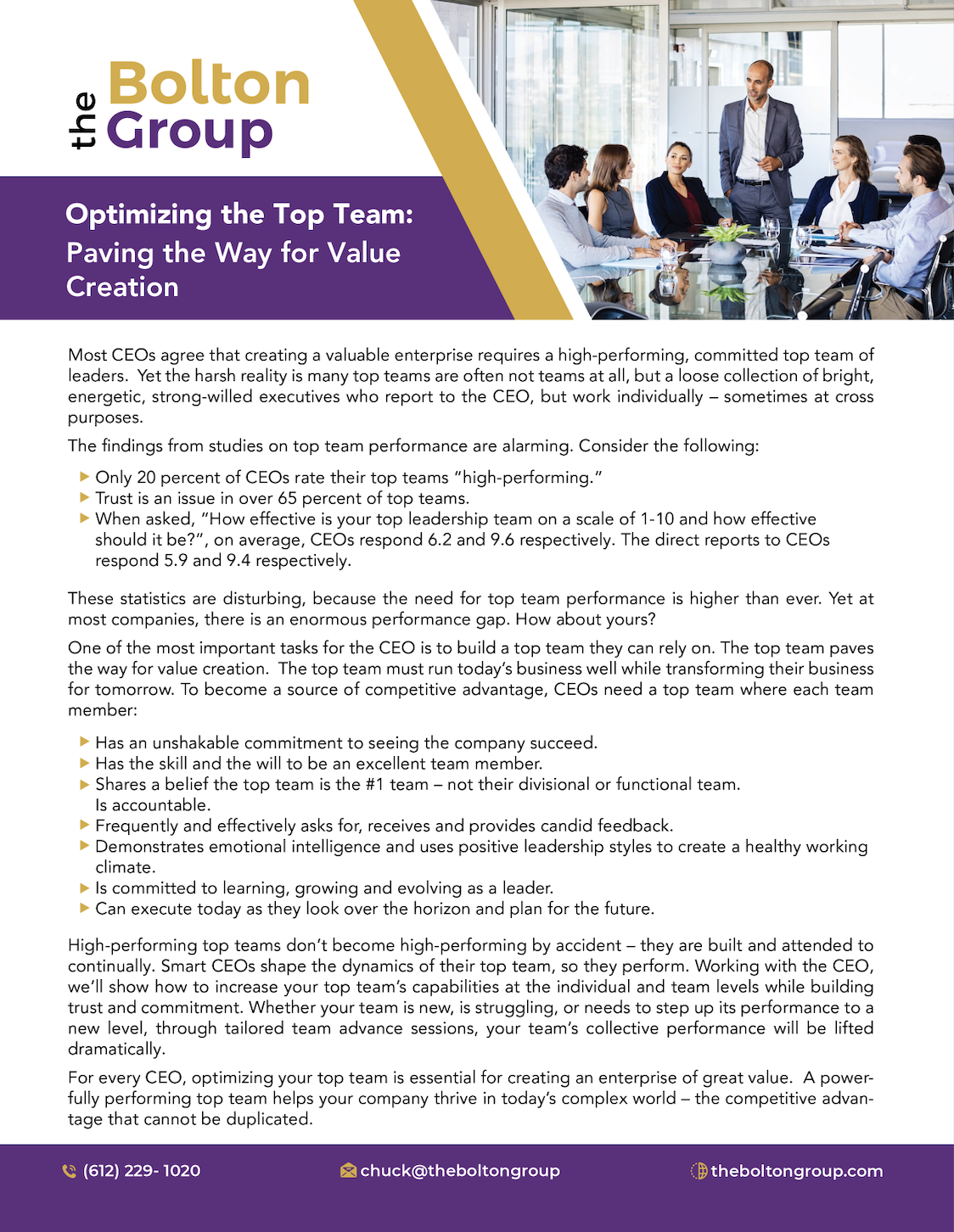Three Costly Mistakes CEOs Make with Their Top Teams
The confidence level CEOs have in their top executive teams dropped 7.1% the past eighteen months, as reported by the Leadership Confidence Index. This news is alarming, given the prediction of declining growth in 2023 by CEOs surveyed. In this challenging economic environment, CEOs, top teams and their companies must embrace a laser-like focus on creating and sustaining a competitive advantage.
One of the most important tasks for the CEO is to build a top team that can be relied on. Yet, few CEOs believe their top leadership team is performing as it must. The top team should be the CEO’s biggest lever for value creation. However, many CEOs make three costly mistakes that diminish team performance. Remedy these three mistakes and you will be on your way to shaping and leading a top team that delivers.
Mistake #1 – Failure to Create Clarity
The old expression, “If you don’t know where you are going, any road will take you there”, holds true in business. If you aren’t crystal clear about where you are headed, and if your team isn’t aligned and focused on that destination, the execution of your goals simply won’t happen. Reaching your desired future state is impossible without clarity.
The Harvard Business Review article, No One Knows Your Strategy – Not Even Your Top Leaders, reported that in an analysis of 124 companies, only 28% of executives responsible for executing strategy could list three of their company’s key objectives. A study by Bain showed that 60% of employees don’t have any idea what the goals of their company are. They are wandering around, investing effort in ways that don’t contribute to the company’s focus.
How about your team? Have you and your top team defined your company’s place in the world and its purpose? Is everyone clear about your company’s purpose, vision, and key objectives? It’s doubtful.
A recipe for creating clarity is constructing a value creation blueprint with your top team. The value creation blueprint is a working document that identifies your vital growth initiatives and the “who, what, where, when, and how” the company will achieve full potential in a two to three-year timeframe. Grounded in the company’s purpose, mission, vision and values, the value creation blueprint becomes the living document, broadly shared and updated frequently, to create an aligned, mobilized and results-oriented mindset across your business.
Mistake #2 – Failure to Shape Positive Team Dynamics
Team dynamics is how your team works together. Many chief executives underestimate the criticality of positive team dynamics and overestimate the current state of their team’s dynamics. The Leadership Confidence Index findings reported that both top team members and their CEOs are concerned about how they work collectively, how they lead change and how they role model a positive culture. Confidence in leadership team behavior declined 8% in one year.
Great CEOs are obsessed with the psychology and performance of their top teams. They know the dynamics of a top team can make or break a company. Investors understand this, too, as they believe the quality of the top team is the single most important non-financial factor in evaluating a new IPO. When a top team works together with a shared vision and supportive behaviors, the company is twice as likely to have above median financial performance.
How about your team? On a scale of 1 to 10, how is your team performing today and how should it be performing?
The best CEOs invest time, energy and money in building the capability and shaping the dynamics of their teams. That means getting to know one another and learning personal histories. Understanding what makes others tick. Strengthening connections. Discovering how to seek, give and receive feedback continuously, in a supportive way. Encouraging candor and rich debates of differing views before making enterprise-wide decisions. Appreciating that diversity in terms of backgrounds, ethnicity, sex, and ways of thinking leads to better solutions. Take these actions and build a top team that moves faster, innovates more readily and collaborates more effectively to get things done. You will likely need outside assistance to optimize the dynamics of your top team.
Mistake #3: Failure to Perform and Transform
It’s not good enough for the team to focus only on today’s business performance. The team also needs to be focused on transforming the business for tomorrow. You must win today’s race while running tomorrow’s race, too.
The clear message for CEOs and their teams is they must reimagine and reinvent their businesses. To reinvent their business while navigating current operating challenges, CEOs need the help of their C-suite leaders, middle managers and other team members alike. They need to reimagine a company with a bolder value proposition that achieves a more ambitious purpose in the future.
But how can leaders transform the business, reinvent their company, when they haven’t yet reinvented how they lead? To reinvent as a leader is to consciously transform how you operate, connect and lead, so you stay relevant, energized and create maximum value.
The CEO of Moderna, the biotech firm that pioneered the messenger RNA (mRNA) COVID-19 vaccination, Stephane Bancel, says the reinvention of Moderna must start with him. Every quarter, he takes the time to reinvent how he approaches his job – to recraft his role as CEO. What he needs to start and stop doing. The vital functions and key responsibilities that only he, as CEO, must perform.
Bancel reflects on how to bring an even greater sense of purpose to his work. On the relationships he must develop and nurture. And on what he must learn and how he must grow to stay current and thrive.
Are you, and your top team members, reinventing how you lead, like Bancel? Are you recrafting your roles to create maximum value, while you elevate the contribution of the next generation of leaders?
Forty percent of global CEOs think their company will no longer be viable in ten years’ time, if it continues on its current course, reported the PwC’s 26th Annual CEO Survey. With 75% of respondents believing growth will decline in 2023, most CEOs feel it is critically important for them to reinvent their businesses for the future.
CEOs and their top teams need to perform while simultaneously focusing on how to transform. PwC’s CEO study revealed chief executives spend 53% of their time driving current operating performance and only 47% thinking about the future today. The respondents believed 43% of their time should be focused on the current state while 57% should be invested on evolving the business and its strategy to meet future demands.
To transform, C-suite leaders must engage and empower others. They must use more of the visionary and coaching styles of leadership to lift others to execute today’s business, so they can place a greater emphasis on the transformation of the business. They will need to continuously recraft their roles and reinvent their impact so they stay relevant and thrive.
Summary
It’s time for CEOs to double down on optimizing their top teams. Overcome these three costly mistakes and invest the energy, time and resources towards building a top team that creates a valuable enterprise. That’s a competitive advantage that can’t be duplicated. Failing to do so will put the company, and you, in a perilous position.
Creating clarity, shaping positive dynamics, and reinventing top team members’ contributions and roles, while reimagining the business for the future, are the steps towards high performance and value creation.












